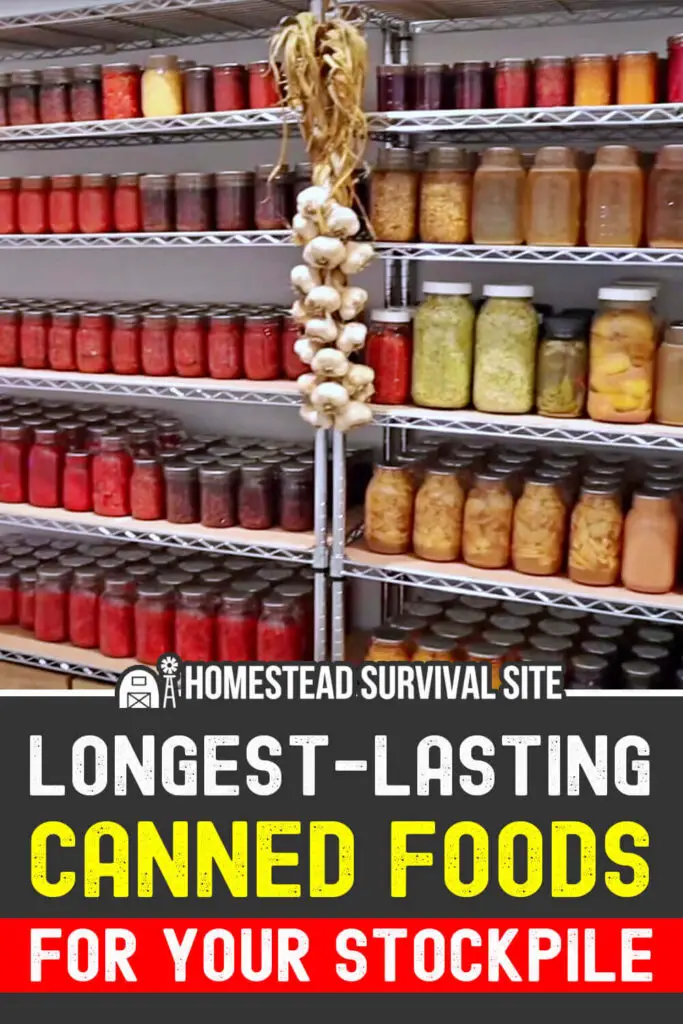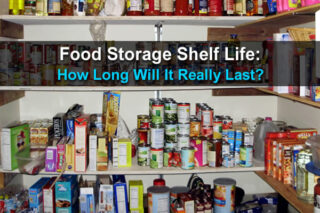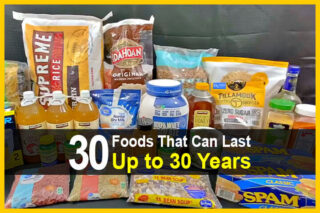Estimated reading time: 10 minutes
Canned goods are a favorite among preppers. If you can’t have fresh or frozen, canned is the next best thing. There are many reasons why preppers will want a healthy supply of canned goods. They are cheap, easy to store and in most cases will last years. Some can last more than a decade.
Canned foods are ideal for emergency use because they don’t require any water, which is important when you’re in a survival situation. Also, you don’t technically need to cook canned foods, which is another important factor when fuel or fire is not readily available.
However, with all things, not all things are created equal. Some canned foods are not going to hold up long while others last for years without losing any real quality. A general rule of thumb are foods that are higher in acid, like tomatoes and fruits, have shorter shelf lives than things like meat and veggies.
The following is a list of the longest-lasting canned foods.
Want to save this post for later? Click Here to Pin It On Pinterest!
Proper Storage
Before we get into the longest-lasting canned foods, we need to talk about how to get optimal shelf lives from your canned foods and other food storage.
- A room with no direct sunlight is best.
- The storage space should be relatively cool. Not cold, but around fifty degrees. Heat will destroy your food just as quickly as freezing temperatures will.
- The space should be dry. Canned foods aren’t nearly as susceptible to being ruined by moisture, but it’s a good rule of thumb.
- Ideally, just as a good practice in general, you want to store your canned goods off the floor. A sturdy shelf a couple of inches off the floor is ideal. If there is a flood of any kind, maybe a broken water pipe or bad weather, it’s best your canned food is not subjected to water.
- Always practice first in, first out to keep your canned food as fresh as possible. You should be using your food storage in your typical weekly meals. When you go grocery shopping, you put the new stuff in the back and take the old stuff into the kitchen.
- Use by, sell by and expiration dates are all subjective. Just use good common sense. Any can that’s bulging or leaking is a hard no. Don’t even open it. When in doubt, toss it out. If you open a can and see it’s moldy, toss it. If it smells funky, don’t touch or taste—toss.
Canned Vegetables—3 to 10 years
- Tomatoes are typically good for about three years on the shelf. Tomatoes are going to be a great source of vitamins B and A, which is necessary when you’re not eating the most balanced diet.They are extremely versatile and definitely deserve some room on the shelf.
- Corn is one of those veggies that is a crowd pleaser and can be cooked up in a variety of ways or eaten cold in a bean salad. It’s high in starch, calories and carbohydrates which is great for an energy boost.
- Peas are delicious cold or hot. They can give a little boost of vitamins in anything from stew to a cold salad.
- Green beans are high in nutrients and can be added to a plain bowl of rice or pasta to give it some additional nutrition.
- Asparagus
- Beets are high in sodium, which can be risky if you don’t have plenty of water. However, they are high in fiber which can be very important when you’re not eating a balanced diet.
- Spinach is Popeye’s favorite for a reason. It has all the nutrients you need to feed your muscles.
Canned Fruit—2 years
Is a flavorful way to get some vitamins and minerals in your diet. Generally, fruits are always going to be crowd pleasers. Eat them fresh out of the can or mash them for toast or whip up some kind of dessert to change up your survival diet. Unfortunately, canned fruit does not hold up for decades. The healthiest option is fruits canned in water. However, and this is a big one, the syrup used in canning fruit is a good source of sugar and calories in a survival situation. You’re not likely going to be too worried about counting calories to lose weight in survival.
- Peaches are rich in vitamin C.
- Pineapple is rich in vitamin C and other important nutrients, but it also helps reduce inflammation. It is often recommended to help ease arthritis pain.
- Fruit cocktail is perfect for getting a little bit of everything.
- Pears are high in water, which doesn’t do much for your calories, but can help stave off dehydration when water is in short supply.
- Mandarin oranges obviously have a lot of vitamin C, but they also offer potassium and fiber.
- Apples also have vitamin C as well as fiber. You can mash them into applesauce. Applesauce is good to have on hand in case someone gets a stomach bug and needs something light on the belly.
Canned Beans—3 to 6 years
Storing canned beans is a good idea. Dried beans will definitely last longer, but they also require a long cooking time and water, two things that might not be readily available in a survival situation. Canned beans are ideal for making a quick meal that doesn’t require more than a few minutes to cook.
- Pinto are probably the most popular because they are so versatile. Eat them plain or toss them in a stew or chili. You can mash and fry them to make refried beans.
- Navy beans are higher in carbohydrates than it’s counterparts. They also have lots of calcium to help makeup for a lack of dairy in the diet.
- Black beans are packed with fiber, iron and protein; three things that are going to be critical to good health.
- Lentils are lower on the calorie scale, but they are nice and tiny and can be added to a soup or stew to make it just a little heartier.
- Kidney beans are loaded with carbs and fiber. They also have some protein.
- Chickpeas aka garbanzo beans are rich in b-vitamins.
- Soybeans are packed with protein. If meat is in short supply, a cup of soybeans can replace your meat source. They are also high in magnesium which promotes healthy muscles.
- Baked beans are a stockpile staple. Eat them as a meal. Some varieties have bacon included. They are a comfort food to keep on hand.
Canned Fish—3 to 30 years
Ideally, you want to choose fatty fish simply because they are more nutritious. Avoiding fish that are preserved with sauces will also give you an extra few years on your shelf life.
- Canned salmon can be pricey, but if you can afford it, it’s a delicious meal packed with lots of protein and omega-3s.
- Tuna fish is high in omega-3s and can be eaten in a variety of ways. It’s important to limit yourself from eating too much tuna to avoid getting too much mercury in your diet.
- Anchovies are one of those things you love or hate. They can be added to bread or crackers for a protein burst. They are not as high in omega-3s or protein as some of the other fish varieties.
- Mackerel is an oily fish and similar to herring and sardines, but it has the benefit of the omega-3s you want in your diet.
- Canned trout isn’t as easy to come by as some of the other fish varieties. It is similar to salmon with about the same nutritional value.
- Canned herring is an oily fish packed with fat and protein, which is essential to keeping your strength up.
- Canned sardines are not always a fan fave, but they are super cheap and really fatty. Fat is good when you’re on a limited diet. And you get those omegas we keep talking about, twice as much as a can of salmon.
- Canned albacore is a little less fishy for those that aren’t big on that flavor. It is often compared to chicken and has a higher omega-3 level.
- Canned crab meat is a nice luxury. A single can has about twenty-two grams of protein.
- Canned mussels might not sound appetizing, but they are a nice change up and they are calorie dense.
Canned Meats—4 to 30 years!
Get some canned meat on your shelves. It might not be your first choice when there are grocery stores and butchers readily available, but it’s an ideal option when you need protein and there aren’t any stores.
- Chicken that has been processed and can maintain its flavor as well as the protein content. It’s a good white meat option that is relatively inexpensive.
- Beef—one word PROTEIN. You’ll see that a lot, but protein is crucial to keeping your muscles healthy and strong. Something that’s extremely important when you are doing a lot of manual labor.
- Pork is high in protein and can be a change up from red meat, which is a little harder to digest. The more meat you eat, the more water you need to digest it properly.
- Bacon—because who doesn’t love bacon! You can get a good ten-year shelf life when canned right.
- Spam may or may not be considered a meat but it’s good warm or cold. It can be tossed into stew, chili or anything else to give a protein and fat boost to an otherwise boring meal.
- Vienna sausage is another one of those is it a meat things. They’re cheap and a little can is a lot easier to carry. Eat them with crackers to get a full meal high in fat.
Canned Meals—2 to 5 years
Canned meals are things like soup, pasta and so on. These are easy to heat and eat. There are going to be different ideas about how long that can of ravioli is going to last. It all comes down to the sniff test. If it looks and smells okay, it’s good to go.
- Soups in all varieties EXCEPT tomato-based soups will easily last for a few years. Tomato soups will have a shorter shelf life. Soups can be hearty and have all the nutrition you need in a single can.
- Chili is an excellent source of protein and is very filling. It only takes a little to fill a belly.
- Canned pastas like SpaghettiO’s, ravioli and so on are going to be in the tomato family and will likely only stay good for two to three years. These are good to have on hand if you have kids that are used to these “comfort” foods.
- Canned stew will last for two to three years depending on the ingredients. These are a great way to get the vitamins you need from veggies in the stew and protein from the meat.
Miscellaneous
- Broth is going to be a huge help when you’re trying to make meals from scratch. It can be sipped alone for someone under the weather or used to make soups, stews or bean dishes. Store a variety. It will easily store for three to five years.
- Canned milk has a relatively short shelf life depending on what kind you choose, but it’s nice to have on hand to provide a calcium boost and to flavor a dull recipe.
- Canned cheese gets a two-year shelf life. It’s not exactly nutrient-rich, but the flavor it provides is worth the greasy fat. Sometimes, you just need cheese.
- Canned rice is a thing and will be good on your shelf for up to six years. It will give you the benefit of making a soup with the broth you’ve stored without needing to cook the rice. Rice is high in carbs, which means energy when you need it.
- Sauces—all kinds, are generally going to have shorter shelf lives due to the combination of ingredients. Typically, you can expect one to three years.
- Pie fillings are typically fruit and will last about two years. They aren’t technically nutritious, but they can satisfy a sweet tooth and make a nice treat on a dark day.
With all of that said about shelf lives, you are going to meet some people who don’t believe there’s ever a shelf life to follow. It comes down to using good judgement. Some foods, like fruits and tomatoes, really won’t hold up. Mix up your stockpile choices. Variety is the spice of life.
Like this post? Don't Forget to Pin It On Pinterest!
You May Also Like:












